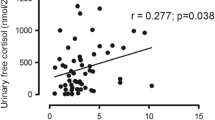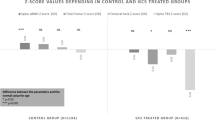Summary
Total body calcium content (TBCa) was estimated byin vivo neutron activation analysis in 16 patients (14 female, 2 male) with active Cushing's syndrome, pituitary driven in all but two cases. Apart from being nonreproductive, patients were unselected. TBCa was below the predicted young normal value in all patients (mean±SD, 85.2±5.8% of predicted,P<0.01 vs. predicted) and in 13 of the 16 patients, was also below the predicted value when allowance was made for expected postmenopausal skeletal losses (mean±SD, 92.7±12.5% of predicted,P<0.02). However, individual values of TBCa were significantly lower (P≤0.05) than the predicted normal range, corrected for postmenopausal losses, in only 3 patients (19% of the group). Initial TBCa apparently was not related to duration of the disease or to current urinary-free cortisol levels. At presentation, radiographic signs of significant osteoporosis (multiple vertebral and/or rib fractures) were present in four patients, three of whom had subnormal or borderline TBCa compared with the young normal predicted range. TBCa measurements were repeated in 9 patients 1–10 years after successful treatment, and were generally unchanged. During this period, only one vertebral fracture (consistent with simple postmenopausal osteoporosis) appeared in these patients. We conclude that bone mass tends to be low in newly diagnosed Cushing's syndrome, but that significant reduction beyond expected postmenopausal losses is relatively uncommon. Successful treatment prevents new fractures without increasing TBCa, suggesting that bone connective tissue can be restored without remineralization.
Similar content being viewed by others
References
Sprague RG, Randall RV, Salassa RM (1956) Cushing's syndrome. A progressive and often fatal disease. Arch Int Med 98:389–398
Reifenstein EC (1958) Control of corticoid-induced protein depletion and osteoporosis by anabolic steroid therapy. Metabolism 7:78–89
White MC, Doyle FH, Mashiter K, Joplin GF (1982) Successful treatment of Cushing's disease using yttrium-90 rods. Brit Med J 285:280–282
Spinks TJ, Bewley DK, Ranicar ASO, Joplin GF (1977) Measurement of total body calcium in bone disease. J Radioanal Chem 37:345–355
Kennedy NSJ, Eastell R, Ferrington CM, Simpson JD, Smith MA, Strong JA, Tothill P (1982) Total body neutron activation analysis of calcium: calibration and normalisation. Phys Med Biol 27:697–707
Doyle FH (1967) Radiologic assessment of endocrine effects on bone. Radiol Clin N Amer 5:298–302
Spinks TJ, Bewley DK, Joplin GF, Evans IMA, Vlotides J, Paolillo M, Ranicar ASO (1979) Observations on total-body calcium in humans with bone disease. In: Nuclear activation techniques in the life sciences. International Atomic Energy Agency, Vienna, pp 763–773
Cohn SH, Vaswani A, Zanzi I, Ellis KJ (1976) Effect on ageing on bone mass in adult women. Am J Physiol 230:143–149
Aloia JF, Roginsky M, Ellis M, Shukla L, Cohn S (1974) Skeletal metablism and body composition in Cushing's syndrome. J Clin Endoc Metab 39:981–985
Nordin BEC, Crilly RG, Smith DA (1984) Osteoporosis. In: Nordin BEC (ed) Metabolic bone and stone disease. Churchill Livingstone, Edinburgh pp 1–70
Eisenhardt L, Thompson KW (1939) Brief consideration of present status of so-called basophilism with a tabulation of verified cases. Yale J Biol Med 11:507–522
Urbanic RC, George JM (1981) Cushing's disease—18 years' experience. Medicine 60:14–24
Cushing H (1932) The basophil adenomas of the pituitary body and their clinical manifestations. Bull Johns Hopkins Hosp 50:137–195
Iannaccone A, Gabrilove J, Brahams SA, Soffer LJ (1960) Osteoporosis in Cushing's syndrome. Ann Int Med 52:570–586
McConkey B, Frazer GM, Bligh AS (1962) Osteoporosis and purpura in rheumatoid arthritis. Prevalence and relation of treatment with corticosteroids. Quart J Med 31:419–427
Wang CC, Robbins LL (1956) Cushing's disease: its roentgenographic findings. Radiology 67:17–30
Jackson WU (1958) Osteoporosis of unknown cause in young people. J Bone Jt Surg 40B:420–441
Saville PD, Kharmosh O (1967) Osteoporosis of rheumatoid arthritis: influence of age, sex and corticosteroids. Arth Rheum 10:423–430
Author information
Authors and Affiliations
Rights and permissions
About this article
Cite this article
Williams, G., Spinks, T.J., Freemantle, C. et al. Total body calcium measurements using neutron-activation analysis in Cushing's syndrome. Calcif Tissue Int 39, 145–150 (1986). https://doi.org/10.1007/BF02555110
Received:
Revised:
Issue Date:
DOI: https://doi.org/10.1007/BF02555110




